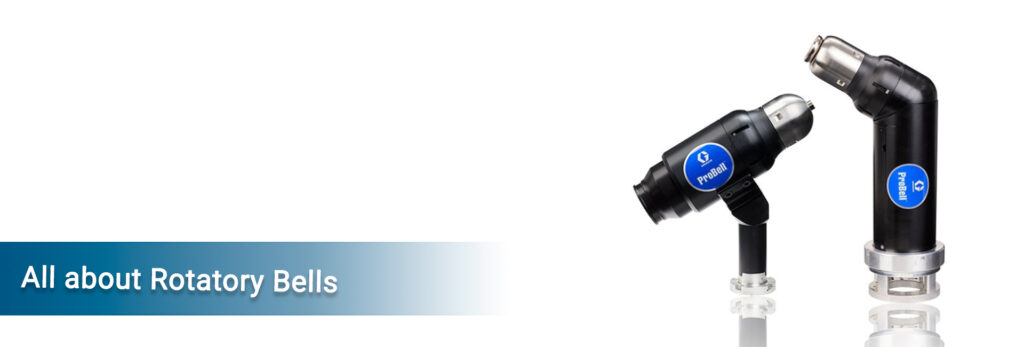In this blog we will learn every basic thing about rotary bells, exploring their types, working principles, numerous advantages, and applications.
Imagine a painting process that delivers an excellent finish each time with maximum efficiency, that’s the magic of rotary bells. It is a revolutionary technology for painting applications. Let’s talk about them further.
Basics of Rotary Bells:
Rotary bells, additionally known as rotary paint bells, rotary bell atomizers, or automatic spray bells are designed for automatic portray systems which impart superior speed, consistency, and transfer efficiency. Gone are the days of relying solely on manual spray guns for large-scale painting projects. These progressive applicators have revolutionised the painting industry.
Different Types of Rotary Spray Bells
While its primary purpose remains the same, rotary spray bells come in various types to cater to specific desires:
- Size Variations: Rotary bells are available in one of a kind diameters, typically ranging from 35mm to 80mm. The length choice relies upon the preferred paint floe rate and the object being painted.
- Shape Variations: The shape of the bell cup can also affect the spray pattern. Concave or exponential designs provide distinct blessings in terms of paint distribution and particle length.
How Rotary Bells Atomizers Work?
The magic behind a rotary bell atomizer lies in its high-speed rotation and its potential to create a fine mist of paint particles. Here’s a simplified breakdown of the bell’s working principle:
- Fluid Delivery: Paint is delivered to the rotary bell at a low PRESSURE, similar to other paint applicators.
- High-Speed Rotation: The heart of this application is the bell cup itself, which rotates at speed exceeding 25,000 revolutions per minute.
- Centrifugal Force and Paint Atomization: As the paint flows via the rotating bell cup, the centrifugal force throws the paint closer to the edges. This movement breaks the paint down right into mist particles which are prepared for the paint application.
- Shaping the Spray: Compressed air is brought to form and direct the paint mist toward the target surface. In a few models, an electrostatic charge can be carried out to the paint droplets for advanced wrapping and adhesion, specifically for complex shaped objects.
Advantages of Using Rotary Bells
Rotary bells offer a variety of advantages that make them a perfect choice for industrial painting applications such as:
- Superior Transfer Efficiency: Compared to standard spray guns, rotary bells attain notably better switch efficiency which means an extra percentage of paint reaches the target surface. This leads to less paint waste and cost savings.
- Unmatched Consistency: The excessive-speed rotation and particular engineering of rotary bells make sure a steady and uniform spray pattern throughout the whole painted floor.
- Exceptional Finish Quality: The high-quality mist of paint particles created with the help of rotary bells permits for a smooth and high quality finish, ideal for applications requiring a wonderful aesthetic.
- Reduced Compressed Air Consumption: Rotary bells operate very efficiently and require much less compressed air compared to conventional spray weapons. This translates to decreased strength intake and operational charges.
- Faster Painting Speeds: The high paint flow rate and efficient atomization system enable rotary bells to achieve substantially faster painting speeds, accelerating production times.
Applications of Rotary Paint Bells
The versatility of rotary paint bells extends to a extensive range of industrial applications such as:
- Automotive Painting: Achieving a flawless finish on car components, frames, and entire vehicle becomes convenient with rotary bells. Their speed, consistency, and minimal overspray make them best for high-volume manufacturing strains.
- Appliance and Electronics: The sensitive nature of equipment and electronic components require a precise and controlled painting process. Rotary bells deliver a uniform finish without damaging sensitive parts.
- Wood Products and Furniture: Rotary bells excel at making use of paint, stains, or lacquers on furnishings and wood products. They offer an excellent and super paint finish. They can also be used for precise applications or difficult moldings.
- Metal Products and Machinery: Providing a protective and aesthetically attractive paint coat on metallic surfaces is critical in numerous industries.
- Plastic Parts and Components: Many plastic elements require a smooth and sturdy paint finish. These paint bells can achieve this sensitive stability, turning in splendid adhesion and a flawless aesthetic.
Rotary Bell Atomizer with Patvin Engineering
Patvin Engineering, a trusted leader in rotary bell technology offers a comprehensive range of high-performance rotary bells from top brand such as Graco, Probell, and Ransburg. These are specifically designed to meet the needs of your industrial painting operation.
Our rotary bells are renowned for their durability, precision engineering, and exceptional performance. They are built to seamlessly integrate into existing automated painting systems, maximizing efficiency and production output.
Don’t hesitate to contact our sales team for further assistance. They can answer your questions and guide you towards the best rotary bell solution to optimize your industrial painting process.
FAQs
Rotary bells offer various benefits over traditional spray guns in terms of efficiency, consistency, and speed. They obtain a higher percentage of paint achieving the goal surface, resulting in much less waste and lower overall painting prices. Additionally, the excessive-speed rotation of paint bells guarantees a uniform and constant spray pattern, removing the possibility of streaks or uneven application.
Regular maintenance is crucial for optimal performance and longevity of your rotary bells.
This commonly includes cleansing the bell cup and air cap after every use to prevent paint buildup and clogging. Consulting the user manual to your particular rotary bell model will offer distinctive cleansing and preservation instructions.
While rotary bells can handle an extensive range of paint viscosities, it is critical to seek advice from paint manufacturers to make sure compatibility with the unique rotary bell model you are using.



